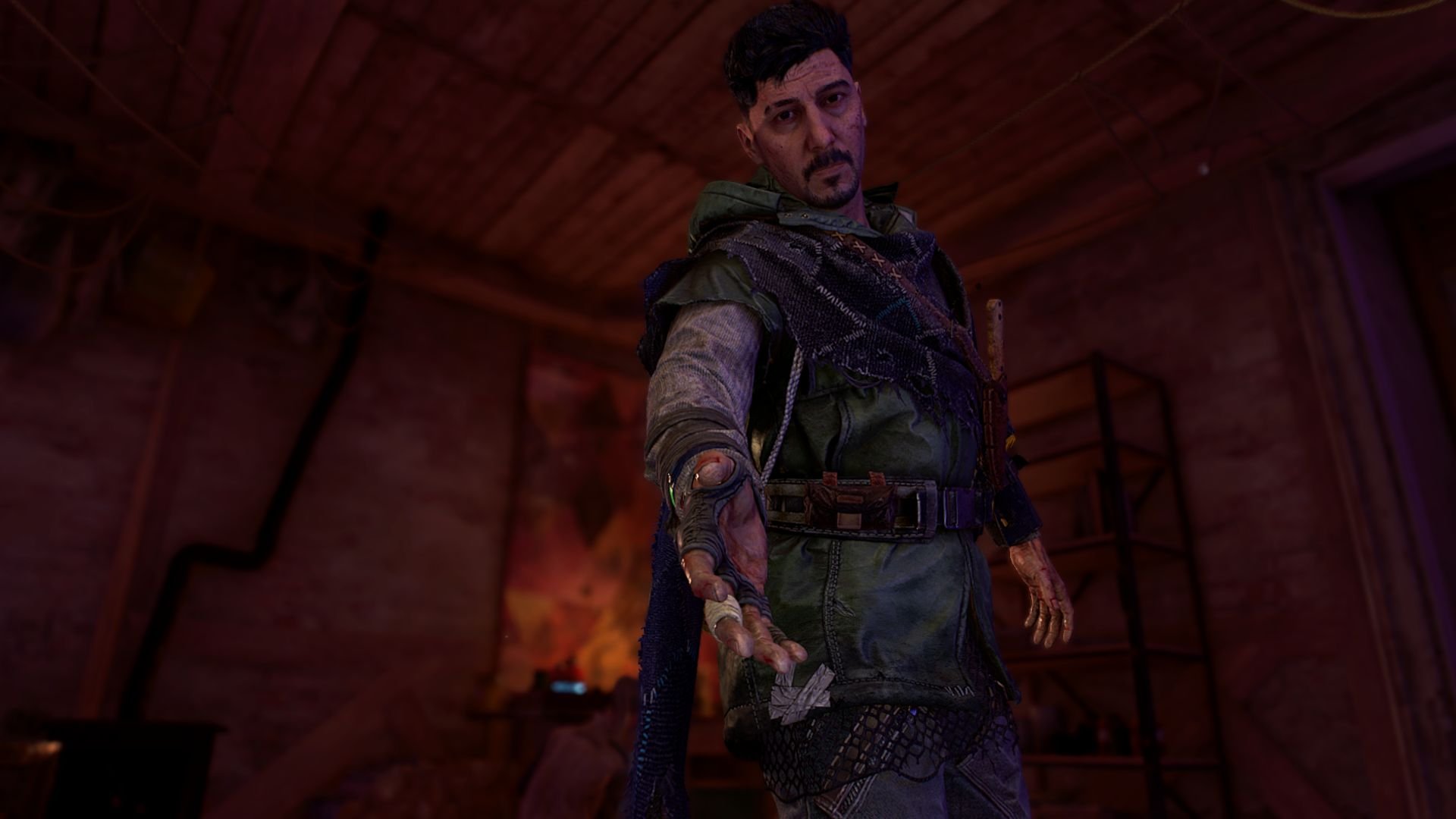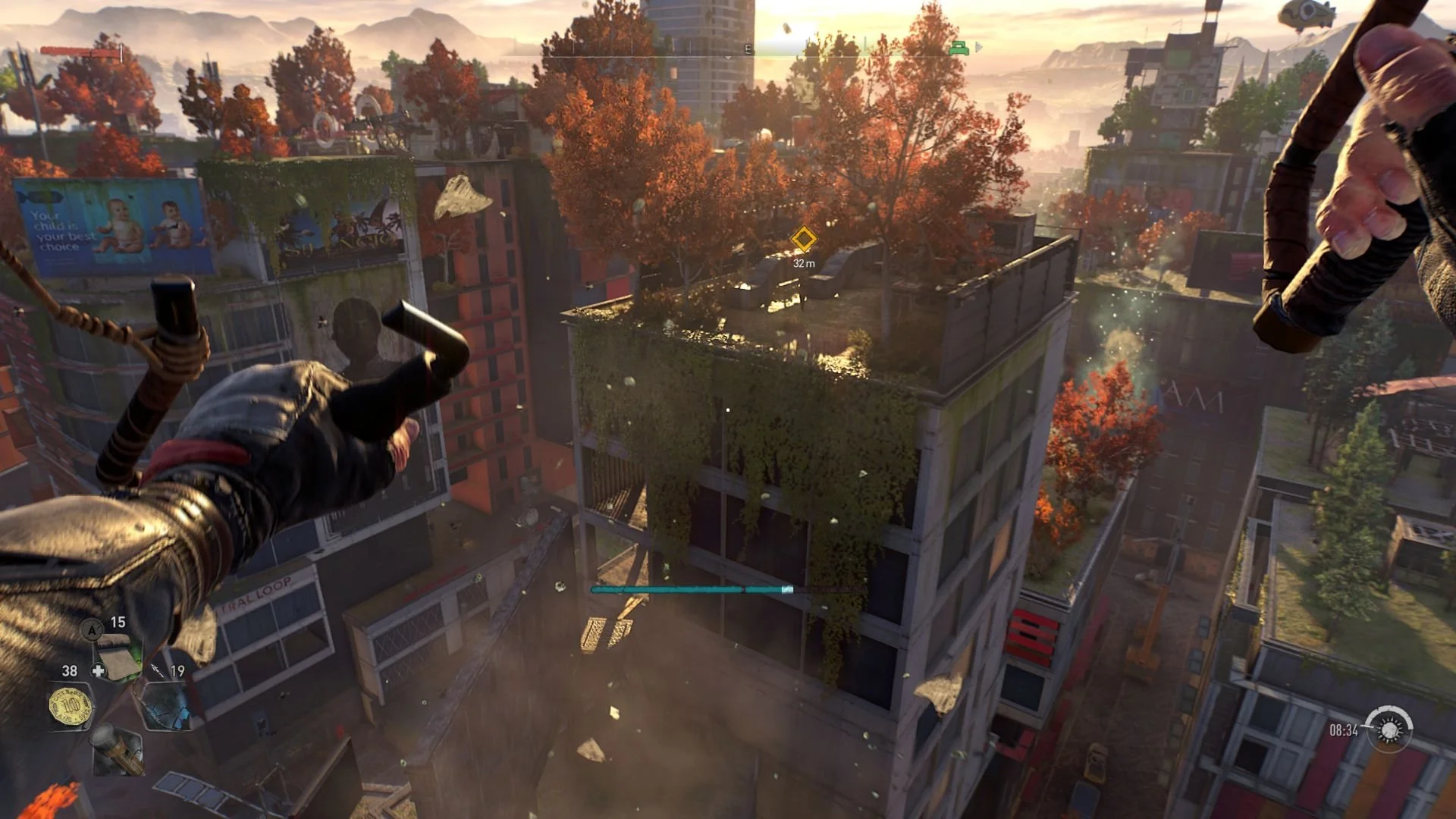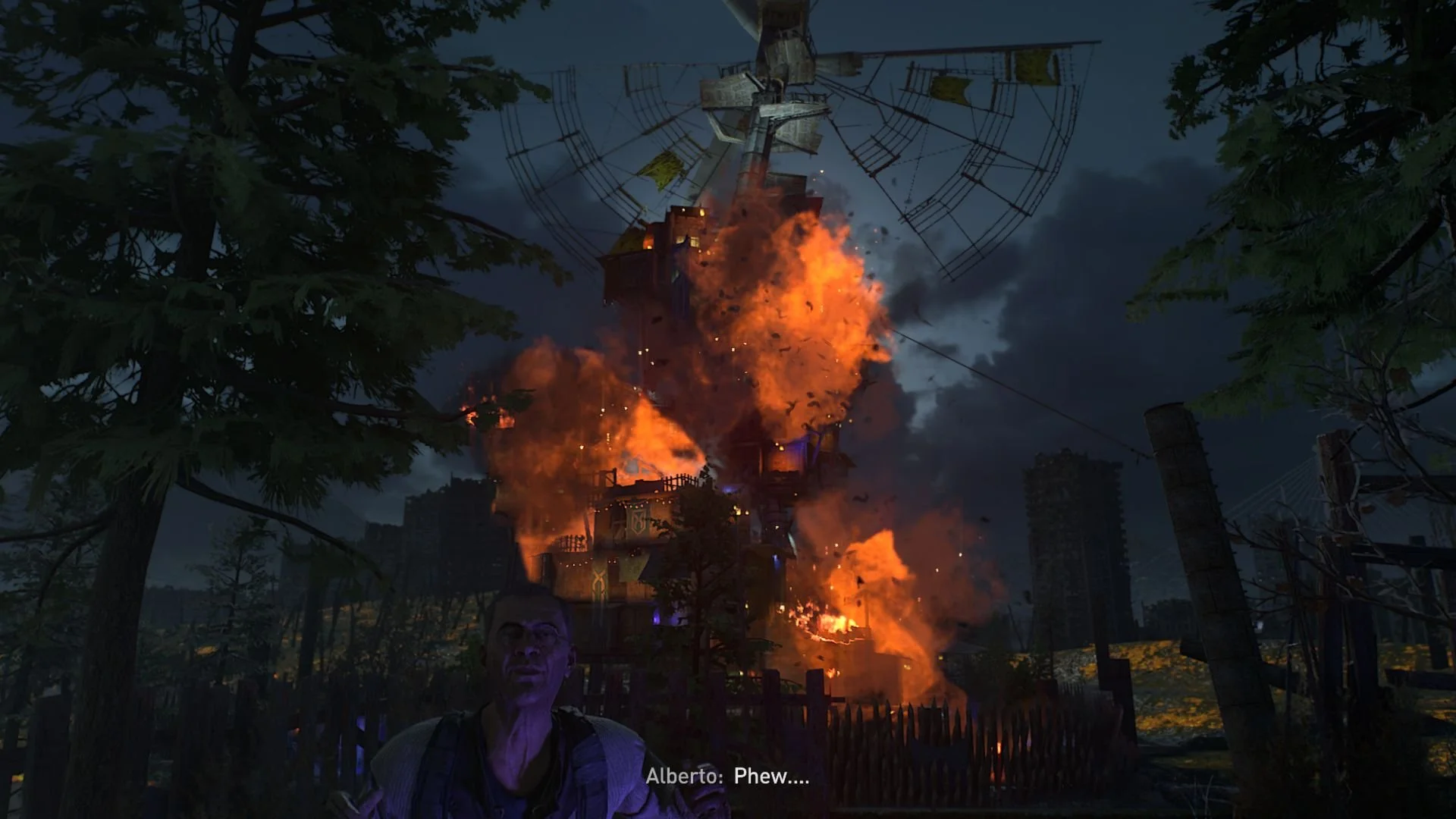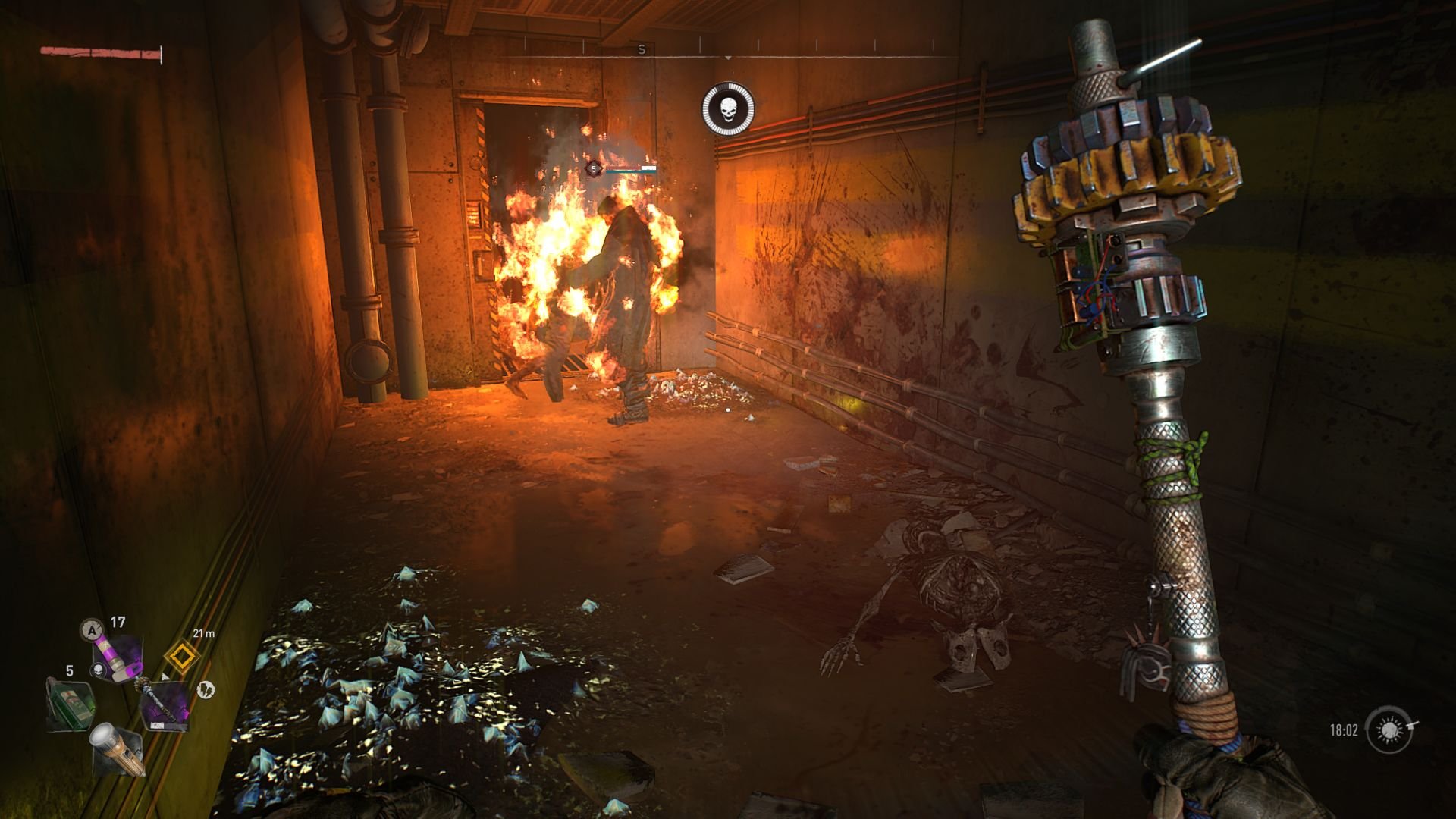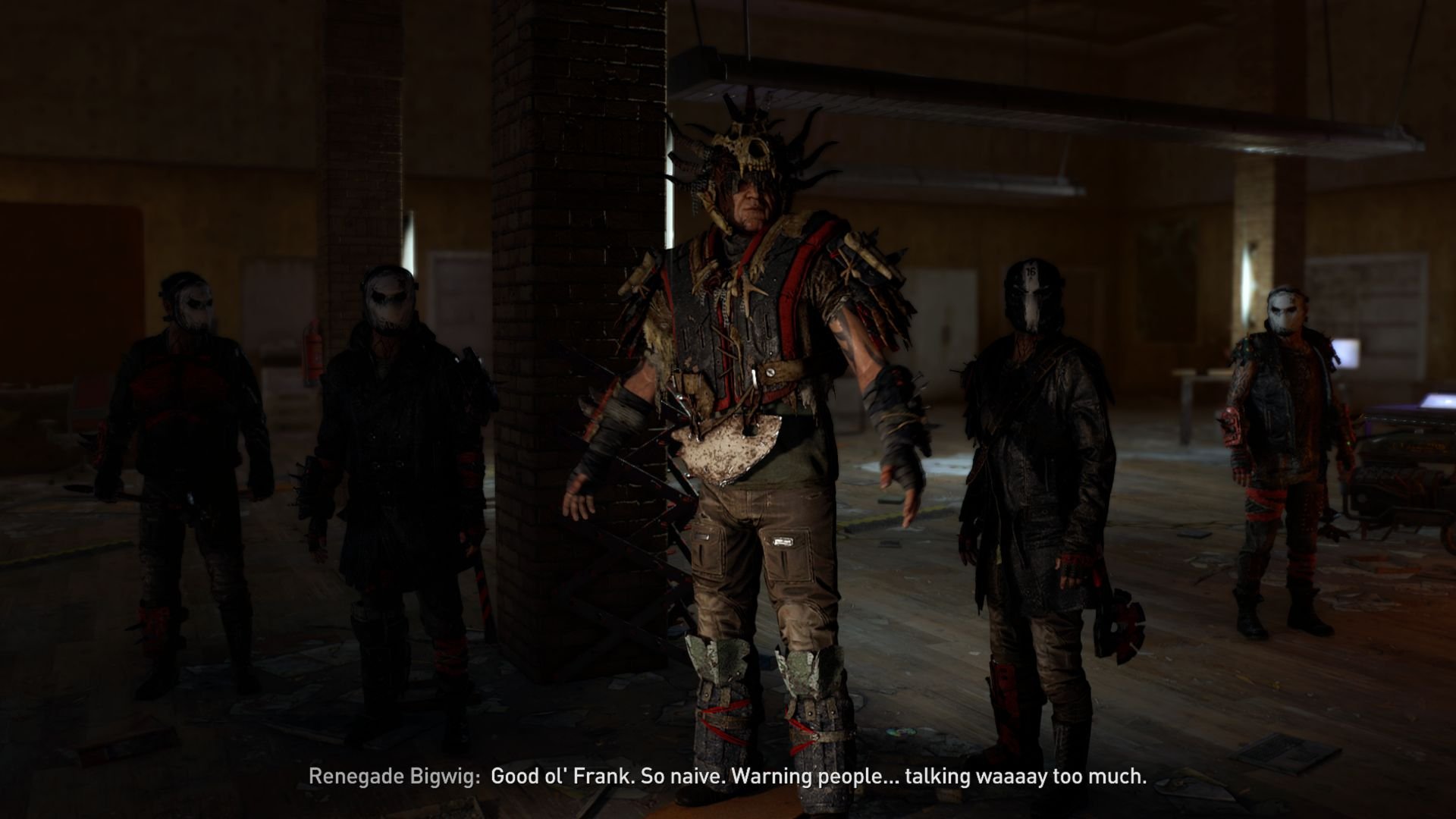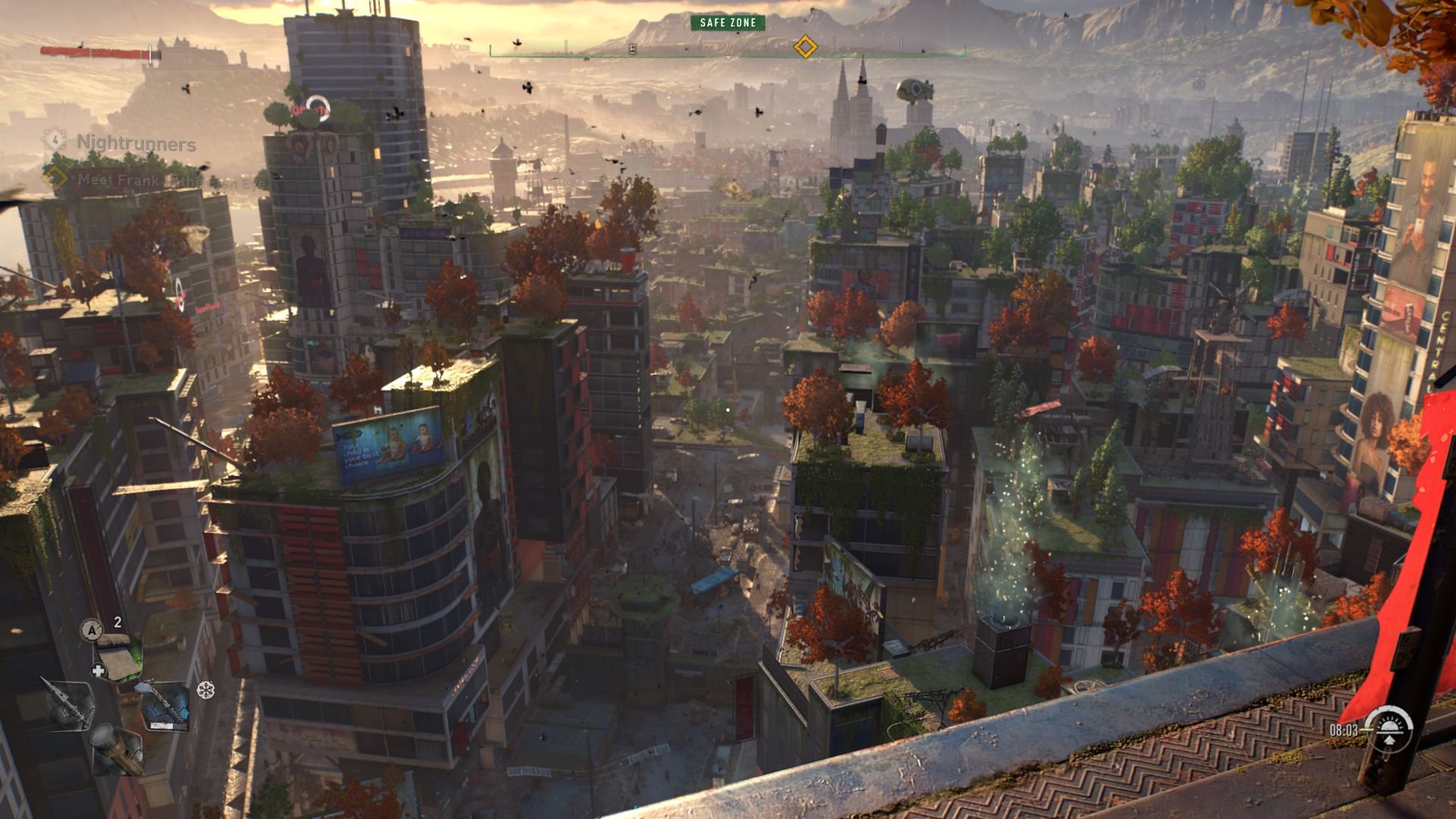Infection Detection.
Dying Light 2 is a tale of two experiences. You have your story of humanity’s survival and its melee and parkour sandbox. Together, you'll find yourself hacking and drop-kicking through the zombie-filled streets of Villedor in an effort to find your sister, all while trying not to get too caught up in a faction war that threatens to tear the city apart. While Dying Light 2 largely succeeds with its visceral combat and traversal systems, it fails at creating an engaging narrative or giving us a memorable cast through its often too overwritten story.
You are placed in the athletic running shoes of one Aiden Caldwell, a man given a tip about the location of his long-missing sister, Mia. There is more to the story here obviously, but much of it is based upon a man named Waltz threatening to bring destruction to the city, not to mention a macguffin in the form of a specialized key, which is apparently some form of full-access device that can spell doom if Waltz gets ahold of it. If you think for a second that that doesn’t happen, then let me introduce you to some common sense as this game’s story is wildly predictable and extremely unsatisfying.
The appeal of what Dying Light 2 does here with its story, and what is part of that touted 500 hours to see everything this game has to offer, is that you'll have a variety of choices to make, changing the narrative in small to significant ways that color the ending you'll eventually earn, even if I just couldn't come to care about who lived or died by the end. When Dying Light 2 was first announced, we were made to believe that some choices would drastically change up the world, and while some aspects of that are here in minor ways, the major overhauling changes those choices were promised to do is simply not, likely due to narrative lead, Chris Avellone, being removed from the company following sexual harassment claims, and much of his content contributions likely removed, at least from what I can assume.
To make these moments stick, the game lacks any sort of manual save, making you live with those choices, even if you don't much care for the consequences. I do enjoy that as it makes those choices have real stakes, even if you won't likely care for the narrative fallout of what happens and instead reap the gameplay benefits of what each faction rewards you with from a parkour and combat perspective. These rewards come from granting ownership of power stations and water treatment plants, offering you various rewards like horizontal zip lines or car alarm distractions, each based on who you give access to these locations and why.
It's also weird doing a mission for the Peacekeepers to take over a power station, then giving it to the survivors and nothing being said about it once that mission was all said and done. The Peacekeepers were just gone, instead of confronting me about why I did what I did. There are plenty of similar choices here , but many of them don't seem to have any noticeable consequences that are felt going forward. There are countless times where these choices don't seem to reflect the world or at least give me the appearance that they did, apart from maybe one single line of dialogue, and that's pushing it in most cases.
To further illustrate my issue, there was a story moment where I had to kill a witness that could spoil everything I had worked towards up until that point, a character that seemed to be pretty damn important to the main story. Sure enough, I was given the option to insure their silence by poisoning some medical herbs. But apart from a single line of dialogue and a moment later on during the last leg of the game, I was expecting far more out of that choice, and I got that same vibe from a lot of the other quests that either fell into the main path or part of the variety of side quests available to do. There is a ton to do here, don’t get me wrong, but so much of it feels like filler to earn experience or various other rewards than anything contributing to shaping its world, something that Techland themselves was going out of their way to promote that it would.
Dying Light 2’s open world and how you interact with it is something we have seen a dozen times before. Side quests and collectibles fill the map amongst the story-driven scenarios and you are often ability-gated in some way until you’ve earned what you need to explore further. Most missions result in following an objective, talking with NPC’s, and following their requests to yet another objective. That said, the gameplay loop of what Dying Light 2 offers does make up for some of this, as combat is thrilling enough to the point where you’ll often want to seek out danger, and the parkour is just good enough that you can run away if said danger is a bit too much for your level. But it is the narrative elements and how they are structured where you’ll often find Dying Light 2 to be repetitive in its execution, and you’ll likely find a strong urge to skip any and all dialogue. While much of this dialogue is to give personality to the quest via its characters, the poor writing and performances just make you want to skip those scenes entirely and just follow the objective marker to its repetitive conclusion, snagging some rewards in the process.
While running all these missions, whether they service the plot or fill your inventory with rewards, the game has Aiden trying to control an infection that is spreading throughout his body. You’ll have to rely on UV lamps and other items to control it, and those UV lamps can also provide a bit of respite from the zombie hordes as they sizzle and pop in the bright purple glow. You can hoof it from rooftop to rooftop and keep your engagement largely zombie-free, or take to the streets and hope you don’t cause a big zombie rush train behind you, having you scramble to a UV lamp location or hiding in the tall grass and hoping they don't see you. While the streets will still have shamblers here and there during the day, it’s when night hits where the streets become sheer terror as several enhanced forms will frequent the dark alleys and the barely lit plazas. It is also where you’ll find small little boss encounters that usually have some solid items to unlock for your troubles. These encounters are, for the most part, some of the best content in the game. The game will actually present an alert to you that you need to return there at night, and I strongly suggest you do.
You’ll also contend with a lot of human foes this time around as Peacekeepers and Renegades will be your antagonistic human threats as you roam around the city streets. While there are moments where Peacekeepers may be your allies depending on your choices, you’ll constantly be fighting down the hyper-active Renegade faction, where most of their lot is trying out their own Starscream impersonation for some reason. While the zombie threat will range in their combat and feature set, the human forces all come at you with the same type of weaponry that you’ll have at your own disposal. You’ll counter these attacks with a wide variety of dodges, kicks, counters, or perfectly timed blocks, but honestly, once you unlock the dropkick, you’ll likely be boot-slamming them off every tall building you come across, and yes, it never gets old, even if pressing RB to jump and double tapping LB to dropkick feels like one button too many to pull off constantly.
Combat against these human foes is going to be a lot of the game as for as much of a presence the zombie hordes will have, the story places these human obstacles in your way a great deal more, making the zombie threat more of a backdrop to the story being told here, or something you’ll seek out during your sandbox runs. Depending on how you work through your skill tree, which is split into Parkour and Combat, you’ll unlock different things at different times based on how often you use them and the rewards that certain quests roll out. A few hours in and you’ll start to unlock some of the more basic things like countering an attack, leaping over a stunned foe to drop kick another, or parrying attacks and leaving your foe vulnerable for a follow-up. Combat is easily this game’s best feature as it rarely let me down, especially with the wide variety of modifications you can make to your own weapons. Do you want to set them on fire or cause your blade to drip in poison? Well, if you have the materials or schematics, you can do that.
Parkour, on the other hand, works well when it does and dramatically less so when it doesn’t. I never really found a significant use for the wall running and wish I had not unlocked it as I constantly had Aiden running off the side of a building if I hit it at just the wrong angle, causing me to wall-run and then fall to my death. Until you find a specialized item that you will use to upgrade your health or stamina, you are pretty limited in your climbing as Aiden has the initial stamina of a passed-out toddler, where he even gets tired climbing a simple ladder. Eventually, you’ll get to a point where you can actually cut loose and the parkour starts to feel like something far more functional when you can leap jump over ledges or slide under low platforms. The problem that this game suffers is that it takes hours to unlock some moves you almost feel like should be part of the core essentials already given to you, especially given that Aiden’s profession is technically that of a runner and how the world right from the get-go is clearly set up for it. There are plenty of upgrades to work towards, but so many of them are far and away useless unless you're desperate for some variety apart from the clearly more functional moves and abilities you’ll prioritize early on.
I also found a few climbing moments where the zoomed-in view that Aiden has to be very restricting to what I had access to see. This was very apparent when I had to climb a series of towers around the city as some of the tools given to you don’t quite work as well as the parkour elements. There were countless times when I couldn’t even see what I was latched on to, especially that of hanging onto striped vertical pillars. Aiden would often not grab onto some ledges properly, but this may have been more of a glitch or some sort of bug as my time with the game was littered with them consistently. Hell, for nearly an hour, I had black squares popping up and obscuring my vision. I would reset and see it fixed, only for it to happen again and again.
Eventually, you’ll unlock a paraglider, allowing you to glide from building to building and even up into the sky if you find these very video-gamey air currents that suddenly appear all over the game once you’ve unlocked the glider. My biggest issue is how the glider uses your own personal stamina as a gauge for how long you can remain in the air, refilling in full if you pass over one of the many vents available to you. The glider certainly helps you move faster and farther, as does a pretty enjoyable grappling hook, even if one particular climb in a red-walled location made me almost hate it for a while. It’s a far cry from how enjoyable the grappling hook was in Halo Infinite, but there are some moments where you’re a hundred stories or so up a building and using it to swing around the corner, catching a glimpse of the world far, far below you that is often thrilling as all hell.
To aid Aiden in attempting to track down Mia, you’ll have a wide range of tools and weapons to keep you alive as well as a wealth of gear as well. Gear ranges from shoes, pants, bracers, and more, each available in different rarities and stats. You’ll find clothes constantly and can allow you to work towards making some sort of build. While weapons have less stats than clothes, you can outfit them with items through an arrangement of two sockets that allow them to be enhanced further to apply elemental damage such as shock, frozen, or flame. There is a third socket, but it’s mainly just for charms that don’t really do anything. Weapons cannot be repaired, but equipping parts to those sockets will make them far more durable, so it’s always good to horde resources in order to afford those enhancements. Otherwise, you’ll be making various knives, bombs, or Molotov items that can be placed in a hot bar for quick access, each of which are craftable in the same means as your weapon enhancements.
When you cannot reach a UV lamp, you’ll have to fashion immunity boosters, track down UV shroomz, or various other health items that will keep you alive. You can boost the schematics of anything you’re able to craft to make their effects more potent, so you’ll always want to be on the lookout for supplies as you come across them. While some supplies can be purchased at the various encampments, some core materials cannot. Some healing items are very easy to craft as some only need chamomile and honey, which can be found on plenty of rooftops, so you’ll always want to keep an eye and ear out as you can hear the bees swarming around several rooftops.
Aiden also can rely on a survivor sense, which is your typical “detective vision” mode that is part of nearly every game now. The issue I have with it is that you’ll be using this vision mode far too often as some objects are nearly impossible to see as they don’t stand out enough. I also wish the items remained visible longer, but the biggest issue is that 80% of my time with the game, my survivor vision would not work. I would click in the right analog stick and nothing. Sometimes it would work and most often it would not. This kept being an issue no matter how many times I reset. It’s a shame that so much of your discovery of items and what is around you is regulated to this as you’ll want to spam it constantly, making its use relied upon far too much and becomes more of a chore than a tool.
During part of the game’s opening moments, you are given the macguffin of the game, a specialized key that can do a lot of good across the city, and a lot of bad should it fall into the wrong hands. However, predictable moments aside, you’ll use it when you come across locked areas or chests, granting you some pretty decent gear should you come across it. There is a moment in the game where someone else was holding onto the key, and despite that, I was still able to open those doors and chests as Aiden would, somehow, present the key and use it. There isn’t a huge chunk of the game where you don’t have it, but still, this feels like a pretty big narrative oversight that felt very odd to see happen. I also had a very glitchy moment towards the end where after using the key and entering into a small container, Aiden suddenly appeared in front of some enemies and it forced the story to proceed. I can’t say more about what happened due to spoilers, but it was incredibly disorientating and made zero sense.
Almost the entirety of Dying Light 2 can be played in co-op and the experience can be largely hit and miss. After the game’s tutorial, which is around two hours long, you’ll have access to join other players or invite them into your game. Largely due to how the game’s narrative branches work, only the host will be able to complete quests and the other three possible players can only earn experience and character progression. It’s also worth noting that you can earn the glider here far faster if you join someone who is a lot farther ahead than you. While players can vote on story choices, the host can pick their own result, making that voting to be largely a gimmick than anything else. Overall, if your co-op partner is only playing the game to tag along with you, then they likely won’t care about the game not saving their story progress.
Given how wide-ranging the story is, I am actually surprised at how much voice acting there is. While most of it is rather bad, there are a few standouts for sure. Jonah Scott, who plays Aiden has got to be the most sound-a-like counterpart to Troy Baker I’ve ever heard and despite his voice sometimes being at odds with the tone of some moments, he knocks it out of the park. A few hours into the game you’ll meet Lawan, and she is voiced by Rosario Dawson, who is by far the most talented of the group here. Honestly, if Dying Light 2 had some sort of secondary campaign based on her, I’d have preferred it to Aiden’s quest, personally. Dawson is a damn fine actress and has dabbled in voice acting before, but here, she absolutely kills it and was easily my favorite character in the game, but given how awful most of the cast is, that’s not really a major compliment. You’ll also meet Hakon, who gives off major “Littlefinger” vibes, as well as a slew of others, but most of these characters only get a moment or two to really shine, and most just come off as poorly written, and poorly performed for you to really care about at all.
Visually, Dying Light 2 can often be a very good-looking game. While a fully decked-out PC with all the bells and whistles is certainly going to outperform a vastly cheaper console, there isn’t much here that disappoints. Characters and the various creatures are wonderfully animated, and the locations are often a joy to explore, with a decent amount of variety across the city. Areas overrun in vegetation look great, and there is a solid sense of lived-in to many of the game’s smaller indoor locations. Areas that can be climbed or traversed are clearly marked, and there is a lot of freedom in where you can go, despite some ability gating that is largely minimal. Overall, there are two display modes present in Dying Light 2; a Quality mode that runs in 4k 30fps, and a Performance mode that bumps the framerate to 60, but drops the resolution down to a standard 1080p on Series X. It is also worth noting that the Series S runs the game at 1080p 30, with the developer indicating the system’s GPU is holding them back from offering a higher framerate.
Again, despite my criticisms, Dying Light 2 can be some amazing fun, but that’s largely because of the sandbox approach to its world. The story and characters may connect with you, but they are far and away the least impressive stuff here. I do wish the parkour was more intuitive and less wonky, but it does work far more than it doesn’t. I still think the combat is easily the best aspect of the game and I often would create some new piece of horror to wield and head out at night to tackle some of the more imposing threats, seeing what treasures their demise would grant me. I still have several side quests to tackle and some item caches to track down, but despite the combat pulling me into the game to a degree, there isn’t much else that has me drawn to invest more than the 25-30 hours I have already. Dying Light 2 can certainly be a lot more fun with friends, but that can be said of a lot of mediocre games as well. Again, there is fun to be had here, just don’t expect its world or story to keep you invested.
Developer - Techland. Publisher - Techland. Released - February 4th, 2022. Available On - Xbox One, Xbox Series S/X, PS4, PS5, Windows, and Cloud for Switch (TBA) Rated - (M) Blood and Gore, Intense Violence, Strong Language, Suggestive Themes.
Platform Reviewed - Xbox Series X. Review Access - Dying Light 2 was purchased by the reviewer.


